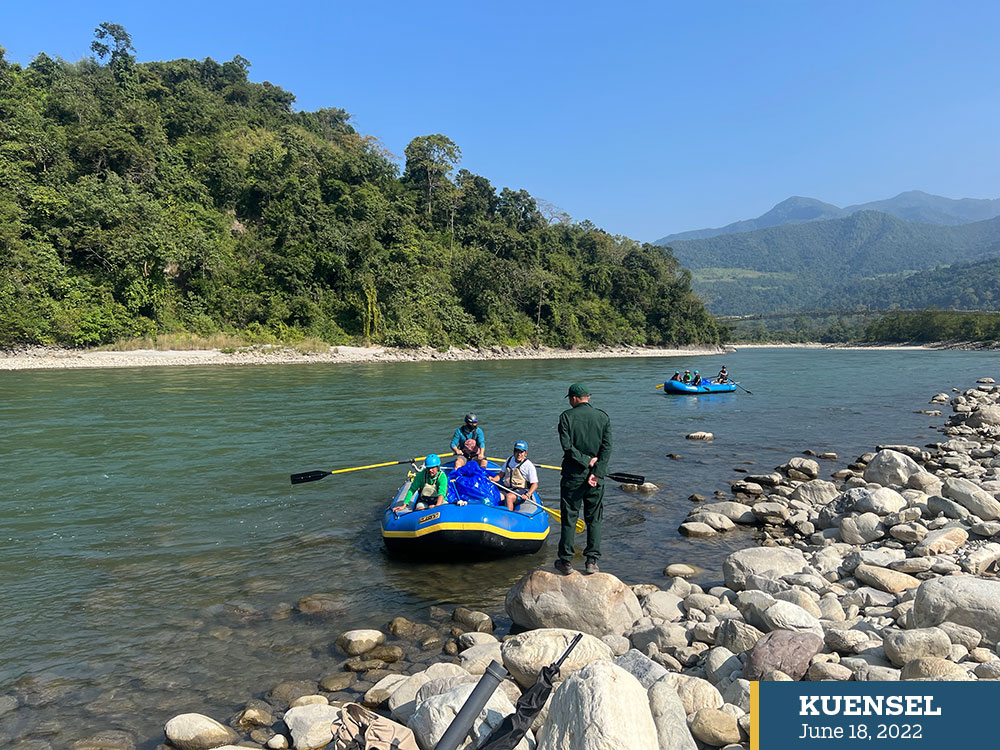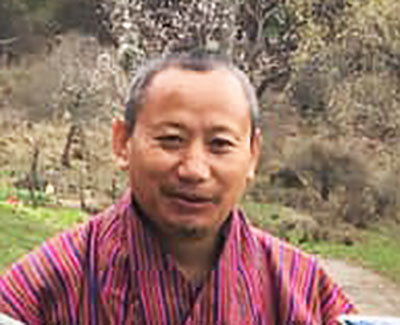“The district has 33 species of mammals, 234 species of birds, 41 species of herpetofauna, 207 species of butterflies, 60 species of moths, 93 species of orchids, and 349 species of wild flowers recorded till date by the Zhemgang Forest Division– while many are still unrecorded.”
Zhemgang Dzongkhag’s boundary intersects with that of the Royal Manas National Park in the south, Jigme Singye Wangchuck National Park in the West and Phrumsengla National Park in the North. About 90% area of the biological corridor (BC 4) connecting these three parks fall inside the Dzongkhag forming 52.45% of the total area under the protected area. Dominated with broadleaf forests, Zhemgang Dzongkhag has 94.17% forest cover, one of the highest in the country.
In terms of biodiversity richness, the Dzongkhag has recorded the highest number of tigers outside the protected areas with a density of 3 tigers per 100 km2 during the nationwide survey in 2015. The second largest population of White-bellied Heron occurs in Mangdechhu and Drangmechhu Basins and their tributaries draining through the Dzongkhag. The Golden Langur that is endemic to Bhutan and Assam State of India is largely found in the entire Dzongkhag. There are 33 species of mammals, 234 species of birds, 41 species of herpetofauna, 207 species of butterflies, 60 species of moths, 93 species of orchids, and 349 species of wild flowers recorded till date by the Zhemgang Forest Division while many are unrecorded.

River Guides of Panbang
Zhemgang has about 3,800 households with over 17,700 residents. The Dzongkhag is traditionally divided into three regions: Upper Kheng covering Shingkhar and Bardo Gewogs; middle Kheng covering Nangkor and Trong Gewogs; and Lower Kheng covering Phangkhar, Goshing, Nangla and Bjoka Gewogs. The people of Kheng are mostly subsistence farmers with major income coming from agriculture farming. The Kamzhing (dryland) and Chhuzhing (paddy field) are dominant land use supported by cash crops such as orange, cardamom and potatoes. The lower regions of the Kheng are popular for bamboo crafting and generate substantial income from the sale of bamboo products.
The lower region of Zhemgang bordering Assam State of India falls within the administrative jurisdiction of the Royal Manas National Park, Bhutan’s oldest protected area established in early 1960s. This park shares boundary with the Manas National Park, India which is a World Heritage Site and Tiger Reserve. Because of this significance, Zhemgang was a hotspot for tourists in the 1980s where Bhutan Tourism Corporation promoted high-end visitors. The tourism in Manas was lifted during the 1990s due to insurgency problems along the transboundary until 2010. For two decades, the access to tourists was restricted and only important official visits of dignitaries and donors were permitted.
Zhemgang is also historically known for early use of the river as means for transportation since the early 1960s. The manual wooden boats were used to cross Manas River from Mathanguri to Manas camp where today Manas Range office is located. Later in the 1970s, a Japanese agriculturist, popularly known as Dasho Nishoka used mechanized boats to transport machineries from India to Bhutan. In 2012, the River Guides of Panbang was formed by local youths to revitalize the legacy of river journey in the Dzongkhag. Both historically and geographically, Zhemgang has potential to develop as one of the top tourist destinations in the country.
The concept of ecotourism started in Zhemgang in 2009 after the first democratic government was elected. The basic idea was to increase local income and reduce rural poverty, generate employment for youth and reduce rural-urban migration. Since the conceptualization, the initiatives at the micro-level have started with support from different government agencies and conservation donors. The ecolodges at Gomphu, Pantang, and Panbang developed by Royal Manas National Park and handover to respective local communities for management. Bermoo Botanical Garden was established in 2015 to provide recreational sites to both the local and international visitors.
Buli Tsho (Lake) and Duenmang Tshachu (hot spring) are two popular destinations in Zhemgang for domestic tourism. Duemang Tshachu is used a healing place for mostly sick and aged population from across the country. Mostly, people come is large group and stay there for one week to four weeks. The accommodation at the tshachu is managed by the Zhemgang Dzongkhag and has a capacity of roughly 100 bed nights. The visitors to Buli Tsho are mostly day visitors. For those who wish to stay back in Buli, there are homestays certified by the Tourism Council of Bhutan.
The annual report of the Tourism Council of Bhutan shows that Zhemgang received 346 visitors and spent 915 bed nights in 2019. Considering the ideal season to visit Zhemgang in dry months (October to March), the accommodation available ranges from 15,660 bed night (single occupancy) to 29,160 bed night (double accoupancy). This shows that only 5.7% of the facilities were currently being availed by the visitors. The potentiality of ecotourism in Zhemgang can easily be supported with existing facilities and services with some modest support from the government to improve it.
Studies also suggest that reorientation of local control over ecotourism business can encourage local people’s participation in making community-based tourism as a rural development mechanism. The disparity due to location, skills and capital investment result in inequitable sharing of benefits with the local community resulting in leakage of local economy. The use of local goods and services, employment of local residents is highly recommended for retaining local economy and avoid leakages from the Dzongkhag. The Tourism Council of Bhutan and the Association of Bhutan Tour Operators should encourage tour operators to use local facilities and services, discouraging them from even importing food items from outside the Dzongkhag.
With only 0.1% of the total arrivals in the country visiting Zhemgang annually, the regional spread of tourists in remote locations of the country is seen as an inevitable challenge. The major factors affecting reach of tourists in remote Dzongkhags including Zhemgang are lack of credible infrastructure, long distance, and poor road conditions. Addressing these challenges could be a prerequisite to promote ecotourism or community-based tourism in the country in the long-run.

Jigme Dorji is a former forester and has done research on community-based tourism in Zhemgang for his master’s degree. He is passionate about rural livelihoods and human-wildlife conflict management. Currently, he works for GEF7 Ecotourism Project.
This series is sponsored by Ecotourism Project “Mainstreaming Biodiversity Conservation into the Tourism Sector in Bhutan” funded by GEF-UNDP through the Tourism Council of Bhutan, RGoB.



